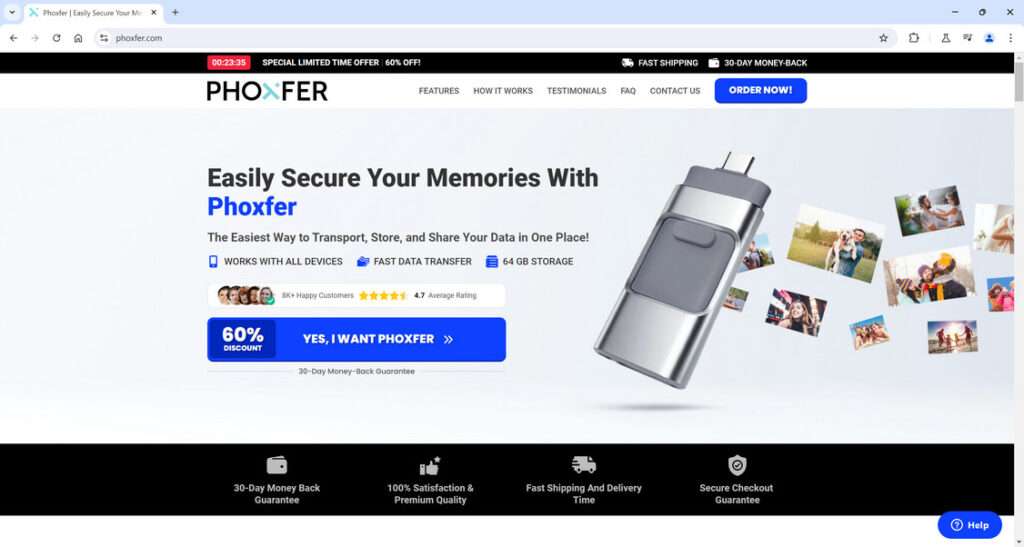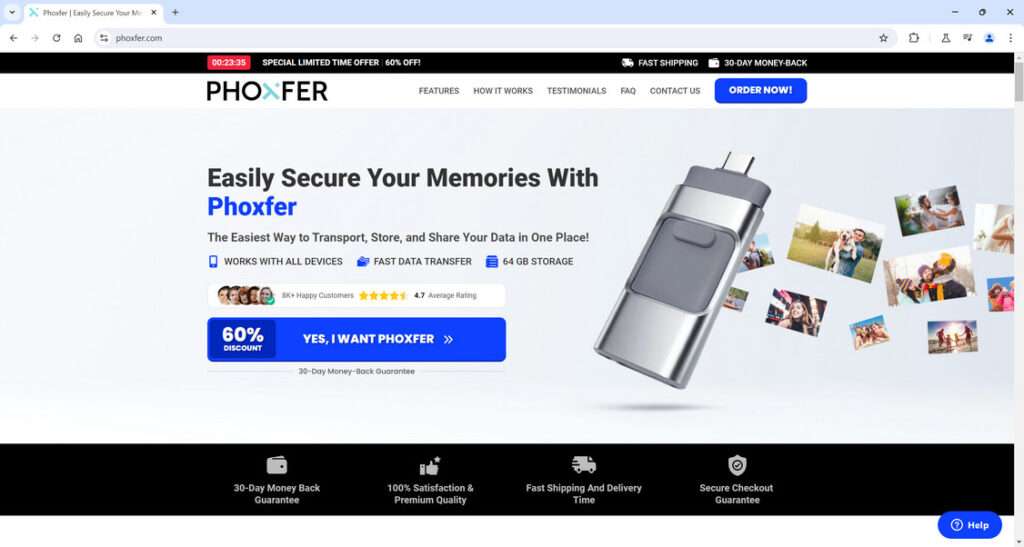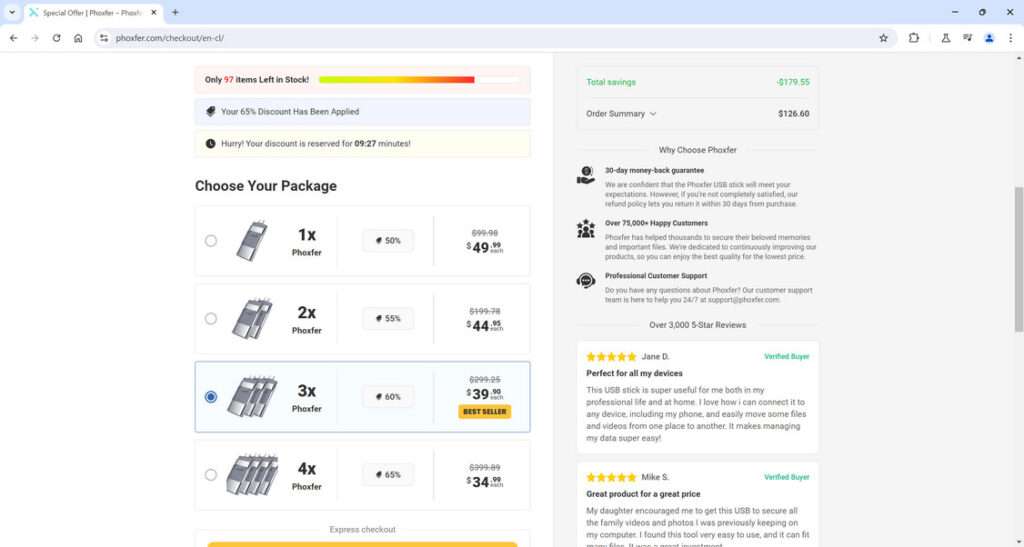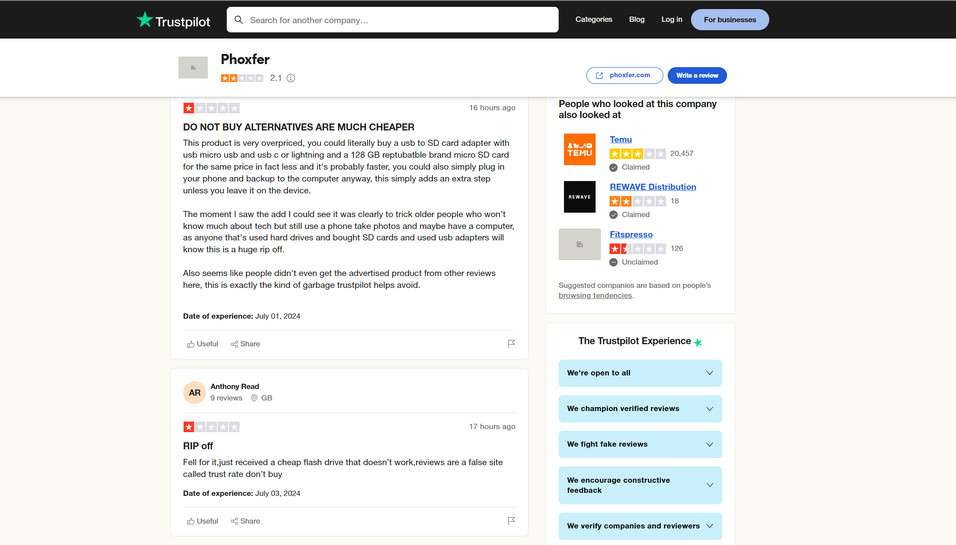A new online scam has been making the rounds, luring unsuspecting consumers in with the promise of a high-quality USB storage device at a heavily discounted price. Known as the “Phoxfer USB Stick”, this product is advertised across social media platforms and promises features like expanded storage capacity, wide device compatibility, and military-grade encryption. However, those who purchase the Phoxfer USB stick inevitably discover it’s nothing but a scam designed to steal people’s money.
This article will provide an in-depth examination of the Phoxfer USB stick scam, including how it works, what victims can do, and key things to watch out for.

Overview of the Phoxfer USB Stick Scam
The Phoxfer USB stick scam operates by utilizing fake advertisements run across social media to lure in potential victims. Most commonly promoted on Facebook, Instagram and YouTube, these ads promise an amazing USB storage device unlike any other.
Supposedly called the “Phoxfer USB Stick”, it is touted as having military-grade 256-bit AES encryption, password protection, a massive 64GB or 128GB storage capacity, and universal compatibility with iOS, Android, MacOS, and Windows devices. It is also advertised as being shockproof, waterproof and dustproof.
Phoxfer ads show the USB stick with a sleek, futuristic design and claim it was engineered by technology experts. Fake reviews and testimonials are used to give the product credibility and convince potential buyers of its quality.

In reality, the Phoxfer USB stick does not exist – or at least, not in the form advertised. The whole thing is a ruse designed to get victims to purchase a cheap, generic USB drive at an inflated price, sometimes up to $100 or more.
How the Phoxfer USB Stick Scam Works
The scammers behind the Phoxfer USB stick scam put a great deal of effort into making their fake product look as appealing and legitimate as possible. Here is a step-by-step look at how the scam typically operates:
Step 1: Fake Website and Social Media Ads
The scammers set up a professional-looking website for “Phoxfer” and create social media ads promoting the product. The website contains convincing graphics, product photos, features lists and customer reviews – all of which are completely fabricated. The ads lead to the site or directly to an order form.
Step 2: Discounted Pricing Strategy
The ads tout special discount pricing like “50% off for the next 24 hours only!” This strategy is intended to create a false sense of urgency and pressure people into buying quickly before the discount expires. In reality, the discount never expires.

Step 3: Customer Places Order
Victims are lured in by promises of military-grade security, massive storage capacity, and wide device compatibility. Believing they are getting an amazing deal, customers enter their payment information – not knowing the product is completely fake.
Step 4: Receive Generic, Low-Quality USB Drive
Weeks later, victims receive a generic, low-quality USB drive in the mail – not the cutting-edge product that was advertised. The USB drive usually has no more than 16GB of storage despite advertised capacities of 64GB or more. It also lacks the promised security features and compatibility.

Step 5: No Way to Get Your Money Back
When victims try to request a refund or return the product, they find it impossible to contact the company. Email addresses bounce back, websites vanish, and phone numbers are out of service. People are left with an inferior product and no way to recoup their money.
Phoxfer’s Abysmal 2.1-Star Trustpilot Rating Exposes the Scam
Phoxfer advertises itself as a top-rated, premium technology brand that customers love. However, their actual Trustpilot review score of just 2.1 out of 5 stars helps expose the scam and steer consumers away.
With 9 total reviews, Phoxfer has zero 5 or 4 star ratings on Trustpilot. An astounding 100% of reviewers left the lowest 1-star rating based on being ripped off.

One victim named Daniel gives a 1-star warning stating “This product is very overpriced…anyone that’s used hard drives and bought SD cards and used usb adapters will know this is a huge rip off.”
Another buyer named Anthony shares “Fell for it, just received a cheap flash drive that doesn’t work, reviews are a false site called trust rate don’t buy.”
Review after review exposes disappointed customers who received cheap, generic USB drives that in no way matched the advertised specs. Multiple people realized the “reviews” on Phoxfer’s site must be fabricated since they do not show up on Trustpilot.
With not a single positive unbiased review, Phoxfer’s true nature as a complete scam is laid bare. No real company could possibly maintain a 100% 1-star Trustpilot rating from numerous victims. This powerful consumer feedback sends a clear signal to steer clear of the dubious Phoxfer USB stick.
Red Flags to Spot the Phoxfer USB Stick Scam
While the Phoxfer scam can look convincing at first glance, there are several red flags consumers should watch out for:
- Too-good-to-be-true pricing – Massive discounts like 50% off should raise suspicion, especially for a supposedly high-end product. Legitimate businesses cannot sustain such heavy discounts for long.
- High-pressure sales tactics – Limited time discount pricing and claims of “only 5 left!” are intended to hurry people into buying before thinking twice.
- No reviews on trusted sites – The website has plenty of 5-star reviews, but none from recognized review sites like TrustPilot or Amazon where feedback can be verified.
- Website registered recently – Scam sites are often brand new, registered within the past few months or less. This can be verified by doing a WHOIS domain lookup.
- Features that seem impossible – Cutting-edge features like 256-bit military grade encryption are highly unlikely in a cheap consumer product.
- Poor English – Scam sites often have grammatical errors, poorly worded claims and other English mistakes.
- No customer service response – Emails and calls go unanswered, a sign that the business is not legitimate.
What to Do If You Are a Victim of the Phoxfer USB Stick Scam
If you unfortunately purchased a Phoxfer USB stick and received an inferior product, or no product at all, there are a few important actions you should take to get your money back and stop the scammers:
File a Chargeback with Your Bank
Immediately contact your credit card company or bank to report the transaction as fraudulent. Request that they reverse the charges due to the seller’s deceptive business practices. Provide any evidence you have, like ads showing false claims. Chargebacks are one of the best ways to get your money back.
Report the Scam to Relevant Agencies
File detailed complaints about the scam with the Federal Trade Commission (FTC), Internet Crime Complaint Center (IC3), Better Business Bureau (BBB), and your state consumer protection agency. Reporting the fraud helps build cases against the scammers and alerts other potential victims.
Leave Reviews to Warn Other Consumers
Post negative reviews about your experience on consumer review sites like TrustPilot to prevent others from falling for the scam. You can also complain on the seller’s Facebook ads and social media pages to expose their deception publicly.
Gather Evidence and Data for Investigations
Save copies of any confirmation emails, receipts, ads showing fraudulent claims, and correspondence with the seller. Screenshot everything. Note down names, addresses, phone numbers, and any other details that could aid law enforcement investigations.
Contact Law Enforcement and Legal Representatives
File a report about the scam with your local police department and with agencies like the FBI and FTC that investigate cybercrimes and online fraud. You can also consult a lawyer to discuss any legal action that may be possible in your specific case.
Remain Persistent and Don’t Give Up
Scammers often hope victims will eventually get frustrated and give up on trying to get their money back. Don’t let this happen. Continuously follow up with your bank, credit card issuer, law enforcement, consumer agencies, and any other relevant parties until the issue gets resolved. Persistence is key.
By taking these steps, you can maximize your chances of getting your money back while playing an important role in helping prevent others from being victimized. Don’t let the scammers get away with it!
Frequently Asked Questions about the Phoxfer USB Stick Scam
1. What is the Phoxfer USB stick scam?
The Phoxfer USB stick scam is an online scam where criminals set up fake websites and social media ads to trick people into buying a non-existent or low quality USB storage device called the “Phoxfer USB Stick”. The criminals promise features like high capacity storage, encryption security and wide compatibility. But people who buy it receive a cheap, generic USB stick not as advertised.
2. How does the Phoxfer USB stick scam work?
The criminals create professional looking websites for “Phoxfer” and run social media ads touting the USB stick as having premium features at a discounted price. Victims place orders but eventually receive a basic, low-capacity USB drive. Their money is gone and they have no way to contact the scammers.
3. What tactics do the scammers use?
The scammers use fake discounts, limited time offers, and made up customer reviews to convince victims to buy the non-existent Phoxfer USB stick. Their websites also showcase false claims about encryption security, storage capacity, and compatibility to deceive people.
4. What are the red flags of the Phoxfer scam?
Red flags include too-good-to-be-true pricing, high pressure sales tactics, no reviews on trusted sites, recent website registration dates, impossible tech claims, poor English, and lack of customer service response. These signs indicate an online scam.
5. How much does the Phoxfer USB stick cost?
Prices range from $50 to over $100, often falsely discounted by 50% or more. The scammers overcharge for a cheap, low-quality USB drive that may cost only a few dollars. Victims pay inflated prices for a product that doesn’t match its advertised capabilities.
6. What capacity and features does the real product have?
The actual USB drive sent to victims has a storage capacity of 16GB or less – not the 64GB or 128GB claimed in the ads. And it lacks the promised security and compatibility features. The real product is a basic, generic USB stick.
7. What should I do if I was scammed by Phoxfer?
File a chargeback with your bank immediately. Report the fraud to agencies like the FTC, BBB, and IC3. Spread awareness about the scam online to warn others. Gather evidence and file complaints with law enforcement to aid investigation. Remain persistent until the issue is resolved.
8. How can I avoid the Phoxfer USB stick scam?
Be wary of unbelievable discounts and pressuring sales tactics. Vet sellers thoroughly and read reviews on unbiased sites. Confirm any too-good-to-be-true tech claims. Pay with a credit card when possible. Use common sense precautions when shopping online.
9. Who is behind the Phoxfer USB stick scam?
The individuals behind the scam remain anonymous. The sophisticated operation indicates an organized group of cybercriminals skilled at online fraud. Their goal is to maximize profits through deception before disappearing and restarting the scam under a new name.
10. Is Phoxfer a real company?
No, Phoxfer is a fake company name made up by scammers to sound like a legitimate tech brand. There is no actual Phoxfer corporation manufacturing USB storage devices. The scammers invented the name and branding to further their scam.
The Bottom Line on the Phoxfer USB Stick Scam
The Phoxfer USB stick scam serves as a harsh reminder that consumers must be vigilant when shopping online. Fake reviews, phony discounts and elaborate websites make it easy for unscrupulous sellers to deceive buyers.
To avoid getting scammed, be wary of deals that seem too good to be true. Vet sellers thoroughly, read reviews on unbiased sites, and confirm security features that sound far-fetched. Also pay with a credit card when possible, to allow chargeback options.
Hopefully this guide has provided helpful awareness to recognize and avoid the Phoxfer scam. Being an informed consumer is the best defense against online retail scams targeting innocent shoppers. Don’t let them fool you – if an offer seems suspicious, it’s always best to trust your instincts and shop elsewhere.
This article is for educational purposes only and does not constitute professional, financial or legal advice. The content is intended for general information and should not be construed as definitive guidance. Information contained herein is subject to change without notice. For concerns, please contact us via the provided form. If you are the owner of the website or product in question and wish to offer clarifications regarding your business or website, please reach out to us through the provided Contact Form.










